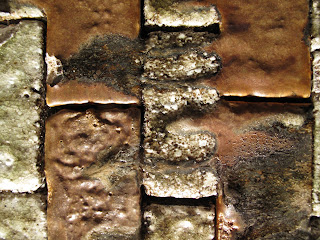Have you ever wondered where those large drips on antique pots such as this come from?
 |
| I love the color variation in the drips on the shoulder, I don't know if you can zoom in enough to see the flecking of other components from the kiln brick, or just general atmosphere. |
 |
| Yes, I'm the person that buys the pots with blobs, chips, and broken handles. They have character! I will say that this bottle was a rare purchase of a non-ovoid bottle. I mostly purchased it for the kiln drips. |
I was crawling around in Sid Luck's kiln the other day and grabbed my camera to take a few photos of the origins of kiln drips. What you are seeing in these photos is a combination of the build up of ash and salt on the interior arch of the kiln, and in some part a degredation of the brick from the ash and salt. Older kilns which did not necessarily have hard brick or soft brick and just used locally made brick broke down faster. Sid was saying this past weekend that his ancestors' kilns were fired until they collapsed in because they were made from local brick.
 |
| This angled shot shows how the melting drips hang from the ceiling. |
 |
| And just like the way in which different clay bodies turn different colors in the kiln, different kiln bricks melt and react differently to their environment. Some of the brick in Sid's kiln was salvaged from his grandfather's (or father's?) kiln, so the darker- colored ones could be made from local clays. |
Kiln drips may also come from glazes of other pots, such as this drip on one of my pots when it was fired in Joseph Sand's kiln.
 |
| The blue drip on the left side of the bottle was not intentional, but very beautiful. |
Historically though, pots were generally only glazed on the interior (if they were glazed at all) until industrialized potteries started glazing the interior and the exterior. And I should say I am referring to stoneware, not earthenware, because that is a whole different ballgame!
And even when the pots were glazed on the outside, sometimes the kiln still got the best of the pot. For example, this alkaline-glazed Meaders piece in the collection of Steve Ferrell in Edgefield, South Carolina has a huge chunk of kiln which fell from the ceiling during the firing, slid down the side of the pot and adhered itself to the base. The fluke of this piece is probably what kept it from getting broken all of these years!
 |
| The chunk of kiln brick is at the bottom left of the piece in this photograph. |









1 comment:
How interesting and so cool to learn of this, love the jug with the brick piece attached and the drips too. I'll keep an eye out in antique stores for these now.
Post a Comment